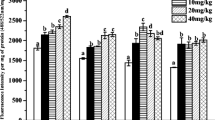Abstract
This study investigated the biomarker responses of the earthworm, Eudrilus eugeniae, exposed to sublethal concentrations of benzene, toluene and xylene (BTX) for a time span of 28 days. Lipid peroxidation (LPO) and histopathological alterations were examined. Toxicological evaluations of BTX were carried out against E. eugeniae. On the basis of the 96-h LC50 value, xylene (1.212 mg/kg) was found to be the most toxic followed by toluene (1.335 mg/kg) and benzene (1.896 mg/kg) was the least toxic. The exposure of earthworms to sublethal concentrations (1/10th and 1/100th of 96 h LC50) of BTX premixed with the substrate (loamy and humus soil) induced pathological changes in the clitella such as severe lesion, necrosis and dark brown pigments. The result of the lipid peroxidation assay showed a significant increase in oxidative damage with LPO values ranging from 2.58–7.8 nM/g in exposed animals when compared to 0.07 nM/g in the control group. The findings from this study suggest the use of LPO and histopathology as useful biomarkers of exposure for early detection of petroleum related stress in terrestrial ecosystems









Similar content being viewed by others
References
Adams, S. M., Greley, M. S., & Ryon, M. G. (2000). Evaluating effects of contaminants on fish health at multiple levels of biological organisation: extrapolating from lower to higher levels. Human Ecology Risk Assessment, 6(1), 15–27.
Anton, F., Laborda, E., & Laborda, P. (1990). Acute toxicity of the fungicide captan to earthworm Eisenia fetida. Bulletin of Environmental Contamination and Toxicology, 45, 82–87.
Bouwman, H., & Reineeke, J. A. (1987). Effect of carbofuran on the earthworm Eisenia fetida using a defined medium. Bulletin of Environmental Contamination and Toxicology, 2, 5–8.
Callahan, C. A. (1988). Earthworms as ecotoxicological assessment tools. In C. A. Edwards & E. F. Neuhauser (Eds.), Earthworms in waste and environmental assessment (pp. 295–301). The Hague: SPB Academic.
Catala, A. (2009). Lipid peroxidation of membrane phospholipids generates hydroxyl-alkenals and oxidized phospholipids active in physiological and/or pathological conditions. Chemistry and Physics of Lipids, 157, 1–11.
Don-Pedro, K. N. (1989). Mode of action of fixed oils against eggs of Callosobranchus maculatus (l). Pesticide Science, 26, 107–115.
Fafioye, O. O., & Owa, S. O. (2000). Effect of oil contamination on mortality of a eudriline earthworm, Eudrilus eugeniae. Nigerian Journal of Science, 34(4), 355–361.
Finney, D. J. (1971). Probit analysis (3rd ed.). London: Cambridge University Press.
Kelly, S. A., Havrilla, C. M., Brady, T. C., Abramo, K. H., & Levin, E. D. (1998). Oxidative stress in toxicology: established mammalian and emerging piscine model systems. Environmental Health Perspectives, 106, 375–384.
Kilic, G. A. (2011). Histopathological and biochemical alterations of the earthworm (Lumbricus terrestris) as biomarker of soil pollution along Porsuk River Basin (Turkey). Chemosphere, 83(8), 1175–1180.
Matthiessen, P., Thain, J. E., Law, R. J., & Fileman, T. W. (1993). Attempts to assess the environmental hazard posed by complex mixtures of organic chemicals in UK estuaries. Marine Pollution Bulletin, 26, 90–95.
OECD (Organisation for Economic Cooperation and Development). (1984). Earthworm, acute toxicity test. OECD guideline for testing chemicals 207 (pp. 1–9). Paris: OECD.
Otitoloju, A. A. (2001). Joint action toxicity of heavy metals and their bioaccumulation by benthic animals of the Lagos lagoon. Ph.D. thesis, University of Lagos, 234pp.
Otitoloju, A. A., & Olagoke, O. (2011). Lipid peroxidation and antioxidant defense enzymes in Clarias gariepinus as useful biomarkers for monitoring exposure to polycyclic aromatic hydrocarbons. Environmental Monitoring and Assessment, 182(1–4), 205–213.
Otitoloju, A. A., Ajikobi, D. O., & Egonmwan, R. I. (2009). Histopathology and bioaccumulation of heavy metals (Cu & Pb) in the giant land snail, Archachatina marginata (Swainson). The Open Environmental Pollution and Toxicology, 2, 79–88.
Sharma, V. J., & Satyanarayan, S. (2011). Effects of selected heavy metals on the histopathology of different tissues of earthworm Eudrilus eugeniae. Environmental Monitoring and Assessment, 180, 257–267.
Stentiford, G. D., & Feist, S. W. (2005). A histopathological survey of shoe crab (Carcinus maenas) and brown shrimp (Crangon crangon) from six estuaries in the United Kingdom. Journal of Invertebrate Pathology, 88, 136–146.
Stentiford, G. D., Longshaw, M., Lyons, B. P., Jones, G., Green, M., & Feist, S. W. (2003). Histopathological biomarkers in estuarine fish species for the assessment of biological effects of contaminants. Marine Environmental Research, 55, 137–159.
Varanasi, U., Stein, J. E., Nishimoto, M., Reichert, W. L., & Collier, T. K. (1987). Chemical carcinogenesis in feral fish: uptake, activation and detoxication of organic xenobiotics. Environmental Health Perspectives, 71, 155–170.
Vethaak, A. D., Jol, J. G., Meijboom, A., Eggens, M. L., Rheinhalt, T., Wester, P. W., Van de Zande, T., Bergman, A., Dankers, N., Ariese, F., Baan, R. A., Everts, J. M., Opperhuizen, A., & Marquenie, J. M. (1996). Skin and liver diseases induced in flounder (Platichthys flesus L.) after long-term exposure to contaminated sediment in large scale mesocosms. Environmental Health Perspectives, 104, 1218–1229.
Yagi, K. (1998). Simple procedure for specific enzyme of lipid hydroperoxides in serum or plasma. Methods in Molecular Biology, 108, 107–110.
Zielinski, S., & Portner, H. O. (2000). Oxidative stress and antioxidative defense in cephalopods: a function of metabolic rate or age? Comparative Biochemistry and Physiology. B, 125, 147–160.
Author information
Authors and Affiliations
Corresponding author
Rights and permissions
About this article
Cite this article
Eseigbe, F.J., Doherty, V.F., Sogbanmu, T.O. et al. Histopathology alterations and lipid peroxidation as biomarkers of hydrocarbon-induced stress in earthworm, Eudrilus eugeniae . Environ Monit Assess 185, 2189–2196 (2013). https://doi.org/10.1007/s10661-012-2700-3
Received:
Accepted:
Published:
Issue Date:
DOI: https://doi.org/10.1007/s10661-012-2700-3




